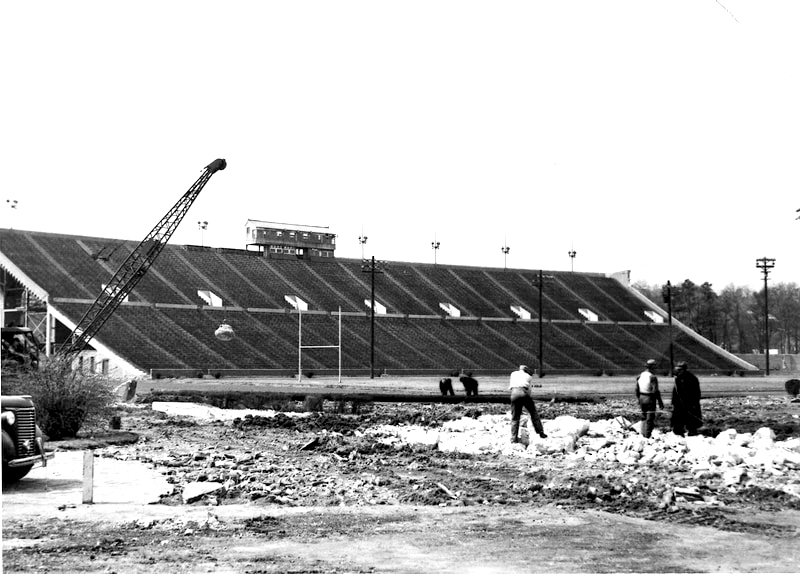A plan to expand the Birmingham Zoo has brought renewed attention to the history of the site as a burial ground for more than 4,700 people.
Zoo officials are seeking a permit from the Alabama Historical Commission to dig up and relocate 12-15 graves to make way for a new cougar exhibit. To create a new cougar exhibit, zoo officials must obtain a permit from the commission after presenting a plan to address graves within the footprint of the new exhibit.
Yet the zoo is not the only Birmingham historic burial ground that has been lost to modern development.
Millions of people for over a century have flocked to Legion Field for events ranging from Iron Bowl showdowns to Magic City Classic faceoffs and even the Olympics. But according to historians, even Legion Field, one of the city’s most storied landmarks, was built on top of a cemetery.
The Old Gray Lady opened in 1927 on top of 322 graves, according to Scott Martin, a vice president and education chairman for the Alabama Cemetery Preservation Alliance.
“From what I understand, the cemetery was abandoned about 1910, and when construction of Legion Field Stadium began, the cemetery was destroyed,” Martin said. “Any existing headstones were removed but the bodies were not.”
Citing records from the federal Depression-era Works Progress Administration (WPA), Martin said the former cemetery contained the remains of about 140 white people and about 175 Black people. WPA workers provided a variety of services including historical research and documenting cemeteries.
On another side of town in Avondale, Martin describes a cemetery that was abandoned in the 1880s and later redeveloped.
“This one is very close to me because this is where my fourth great-grandfather is buried,” Martin said. “This is probably one of the oldest cemeteries in Jefferson County.”
While he knows the location of the site, Martin cannot visit the resting place of his ancestor, James Massey and about 100 other people.
“At one time part of it was used as a city dump and it was destroyed,” he said.
The lost burial site is located on land that is the former Swann Chemical building and extends to the Mayer Lighting Showroom and parking lot.
“During this time there was no authority to monitor this type of activity,” Martin said. “Now of course there’s a protocol that has to be followed. There has to be a permit, there is a process to locate graves, remove remains and then properly rebury those remains.”
Historian Barry McNealy said there are several abandoned cemeteries around Birmingham, some sitting unnoticed and overgrown along well-traveled corridors. And like Martin, he knows of some cemeteries that were completely destroyed by modern development. One former cemetery lies beneath houses that were built across the street from Memorial Park in Birmingham’s Titusville neighborhood.
The destruction of such places carries significant implications, he said.
“It shows our lack of respect for basic humanity and human decency toward all people. Of course, progress has to happen, but that process should respect the memories and the desires of the families of those loved ones,” said McNealy, a historical content expert at the Birmingham Civil Rights Institute “A cemetery is a history book and it’s a repository of narratives that tell our collective story. When you don’t respect that you don’t adequately maintain your community’s history.”
Martin said several factors go into whether burial spaces are preserved or erased. Keeping the spaces in public memory is also key, he said.
Destruction of historic cemeteries occurred around the country. Community activists, preservationists and historians in Philadelphia are working to honor a 19th century burial ground for African Americans.
The site over the years was sold and eventually became a dumping ground and later city park – all over the graves of about 5,000 people. Renovation to the park resurrected the area’s history and calls for its recognition. Plans include adding a historic landmark noting the history of the site, the addition of public art, and reconfiguring the existing park to respect sensitive areas at the historic site.
As it prepares for expansion, Birmingham Zoo officials pledge to balance the need for growth while also respecting the history of the site. The proposed plan includes commissioning an archeologist from the University of Alabama to excavate the area, collect any remains and items interred there and inter them close to the site.
The zoo also intends to add a marker to identify the cemetery in addition to graphics and interpretive information about the history of the area.
“With the majority of this, nobody knows who is where. But we still want to treat the people with the respect they deserve in this process,” Chris Pfefferkorn, president and CEO of the Birmingham Zoo told AL.com “These people had stories, so we want to tell some of that story.”
The zoo is owned by the city of Birmingham. The City Council on August 8 endorsed the application that remains pending with the Alabama Historical Commission.
The cemetery’s presence on the grounds is well documented. The zoo opened in 1954 and the nearby Botanical Gardens opened in 1962.
According to a 1964 article in the Birmingham Post Herald newspaper, workers creating a rose garden at the nearby Botanical Gardens uncovered at least three graves.
Still, Birmingham-area historians agree that the latest proposal at the zoo represents an evolution from the days where there was little regard to preserving what were supposed to be final resting places for the dead.
“That would go a long way in terms of preserving the knowledge, even if the sacred nature of that ground has not been preserved,” McNealy said of the zoo’s proposal.” It’s a very positive step. It’s the best you can do. As we change, are we respecting the past as we move forward? That’s an important question to ask.”









